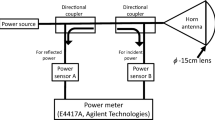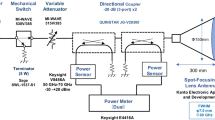Abstract
This paper deals with the interaction between a millimeter‐wavelength plane wave and the human eye. The study has been conducted utilizing the finite difference time domain (FDTD) numerical technique, and an accurate eye model obtained through photographic images of the human head. A partly automatic procedure has been developed to obtain the FDTD‐compatible eye model. The dielectric properties of the human tissues at millimeter wavelengths have been extrapolated from experimental data available at lower frequencies and by using Debye’s dispersion equation. The power distribution in the exposed eye has been calculated in both conditions of closed and open eye, and the results have been compared with the limits settled by some of the most recognized safety standards for human exposure.
Similar content being viewed by others
References
F. Ali and J.B. Horton, Introduction to the special issue on emerging commercial and consumer circuits, systems, and their applications, IEEE Trans. on Microwave Theory and Techn. 43(7) (1995) 1633–1637.
J.Y. Chen and O.P. Gandhi, RF currents induced in an anatomicallybased model of a human for plane-wave exposures (20–100 MHz), Health Physics 57(1) (July 1989) 89–98.
C.H. Durney, The physical interactions of radiofrequency radiation fields and biological systems, in: AGARD Lecture Series 138 (1985) pp. 2.1–2.19.
European Commettee for Electrotechnical Standardization (CENELEC) Prestandard ENV 50166-2, Human exposure to electromagnetic fields. High frequency (10 kHz to 300 GHz) (January 1995).
C. Gabriel, R.J. Sheppard and E.H. Grant, Dielectric properties of ocular tissues at 37°C, Phys. Med. Biol. 28(1) (1983) 43–49.
O.P. Gandhi, Y. Gu, J. Chen and H.I. Bassen, Specific absorption rates and induced current distributions in an anatomically based human model for plane-wave exposures, Health Physics 63(3) (1992) 281–285.
A.W. Guy, J.C. Lin, P.O. Kramar and A.F. Emery, Effect of 2450 MHz radiation on the rabbit eye, IEEE Trans. on Microwave Theory and Techn. (1975) 492–498.
IEEE C95.1-1991, IEEE Standard for Safety Levels with Respect to Human Exposure to Radio Frequency Electromagnetic Fields, 3 kHz to 300 GHz (Institute of Electrical and Electronics Engineers, Inc., New York, 1992).
IRPA Guidelines, Guidelines on limits of exposure to radiofrequency electromagnetic fields in the frequency range from 100 kHz to 300 GHz, Health Physics 54(1) (1988) 115–123.
H.H. Meinel, Commercial applications of millimeterwaves history, present status, and future trends, IEEE Trans. on Microwave Theory and Techn. 43(7) (1995) 1639–1653.
G. Mur, Absorbing boundary conditions for the finite-difference approximation of the time-domain electromagnetic-field equations, IEEE Trans. Electromagn. Compat. 23(4) (1981) 377–382.
K. Pahlavan and A.H. Levesque, Wireless data communications, Proc. IEEE 82(9) (1994) 1398–1430.
J.L. Schepps and K.R. Foster, The UHF and microwave dielectric properties of normal and tumor tissues: variation in dielectric properties with tissue water content, Phys. Med. Biol. 25(6) (1980) 1149–1159.
M.C. Steel and R.J. Sheppard, Dielectric properties of lens tissue at microwave frequencies, Bioelectromagnetics 7 (1986) 73–81.
J.A. Stratton, ed., Electromagnetic Theory (McGraw-Hill, New York, 1941) pp. 563–567.
M.A. Stuchly, A. Kraszewski, S. Stuchly and A.M. Smith, Dielectric properties of animal tissues in vivo at radio and microwave frequencies: comparison between species, Phys. Med. Biol. 27(7) (1982) 927–936.
A. Taflove and M.E. Brodwin, Computation of the electromagnetic fields and induced temperatures within a model of the microwaveirradiated human eye, IEEE Trans. on Microwave Theory and Techn. 23 (1975) 888–896.
K.S. Yee, Numerical solution of initial boundary value problems involving Maxwell's equations in isotropic media, IEEE Trans. Antennas Prop. 14(5) (1966) 302–307.
Author information
Authors and Affiliations
Rights and permissions
About this article
Cite this article
Bernardi, P., Cavagnaro, M. & Pisa, S. Assessment of the potential risk for humans exposed to millimeter‐wave wireless LANs: the power absorbed in the eye. Wireless Networks 3, 511–517 (1997). https://doi.org/10.1023/A:1019162813566
Issue Date:
DOI: https://doi.org/10.1023/A:1019162813566




